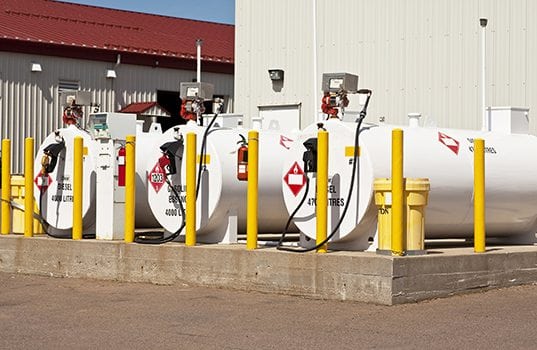By Glen Sokolis, Sokolis Group
If you are managing a large fleet then you have probably found that it is cost-effective to have a fuel storage tank on your property to handle some or all of your fueling needs.
Proper maintenance of the tank is essential – problems can cause maintenance issues with your vehicles, expensive repairs to the tank or vehicles or even a fire or explosion hazard. Government regulations can also affect the testing and inspection which needs to be done, with the public interest in mind – fuel spills, even on a relatively small scale, result in a messy clean-up and can be a hazard to humans and animals. So, what testing do you need to do?
First, you should take a fuel sample at least once a year to check for contamination. The two primary problems are water and, especially with diesel fuel, biologicals. Water in the tank can cause engine failure when that water is transferred to a vehicle. Bacteria and fungi make the fuel more acidic, causing corrosion and ultimately shortening the life of the tank. Biocides are often added to diesel fuel to reduce biological contamination, especially as newer diesel fuel has fewer sulfates, which used to act as a biocide, but which have been removed due to the fact that they considerably added to air pollution.
Second, you should do a proper tank integrity test. The EPA requires periodic integrity testing, but does not specify actual intervals. It also requires visual inspection on a regular schedule. You should have an engineer assess your tank – the frequency of testing and inspection depends on factors that include location and design. Integrity testing should also be done if you have done any repair work on the tank, to make sure you have not compromised it. You should have personnel on site trained to do frequent external visual inspections and a system for reporting issues with a tank that might become obvious to an employee who happens to notice them. The API produces standards to cover the inspection of above ground fuel storage tanks.
Thirdly, all tanks should have a high liquid level alarm and this should be tested regularly – every month or so – so as to reduce the risk of a spill.
So, how often should you test? The short version is: It depends. You need to set a schedule that takes into account the following:
- The design of your tank – some designs are more prone to problems than others.
- The age of the tank – and bear in mind that an ancient tank you inherited from the previous owner of the site may be easier to tear down and rebuild than to repair.
- The location of the tank – where it is in relation to, for example, wildlife areas.
- The speed at which fuel is cycled through the tank. Fuel that sits around for longer needs to be checked more often for biological contaminants. If you have a separate tank for generator fuel you should be especially careful to make sure you test it and use appropriate biocides, as that fuel can sit unused for months or even years.
You should also be aware of any state or local regulations that govern tank design and inspection. Make sure you test any alarms and indicators regularly and educate all employees on identifying high liquid level alarms (even ones who don’t normally work with the fuel tank).
Having a fuel tank on your property can save you a lot of money and a fair amount of employee time – but it also comes with a burden of responsibility when it comes to testing and maintaining the tank so as to make sure it keeps its integrity and does not become a hazard.
 Glen Sokolis is the Founder and President of Sokolis Group, a nationwide fuel management and fuel consulting company. He has more than 25 years of experience with fleet fuel and founded Sokolis Group in 2003. Sokolis Group’s mission is to reduce and control their clients’ fuel spend through tightly managed, customized programs. Sokolis can be reached at [email protected] or 267-482-6160. If you’re concerned about fuel card controls and want to know if you can take any additional steps to help prevent misuse/fraud, contact Conor Proud at Sokolis Group, [email protected] or 267-482-6159.
Glen Sokolis is the Founder and President of Sokolis Group, a nationwide fuel management and fuel consulting company. He has more than 25 years of experience with fleet fuel and founded Sokolis Group in 2003. Sokolis Group’s mission is to reduce and control their clients’ fuel spend through tightly managed, customized programs. Sokolis can be reached at [email protected] or 267-482-6160. If you’re concerned about fuel card controls and want to know if you can take any additional steps to help prevent misuse/fraud, contact Conor Proud at Sokolis Group, [email protected] or 267-482-6159.
Sources:
https://bulkfuel.com.au/news/how-to-test-for-water-in-a-fuel-storage-tank
https://www.atlasoil.com/technology/tank-maintenance
https://www.equipmentworld.com/how-to-set-up-and-maintain-on-site-fuel-tanks/
https://www.fedcenter.gov/assistance/facilitytour/tanks/aboveground/









